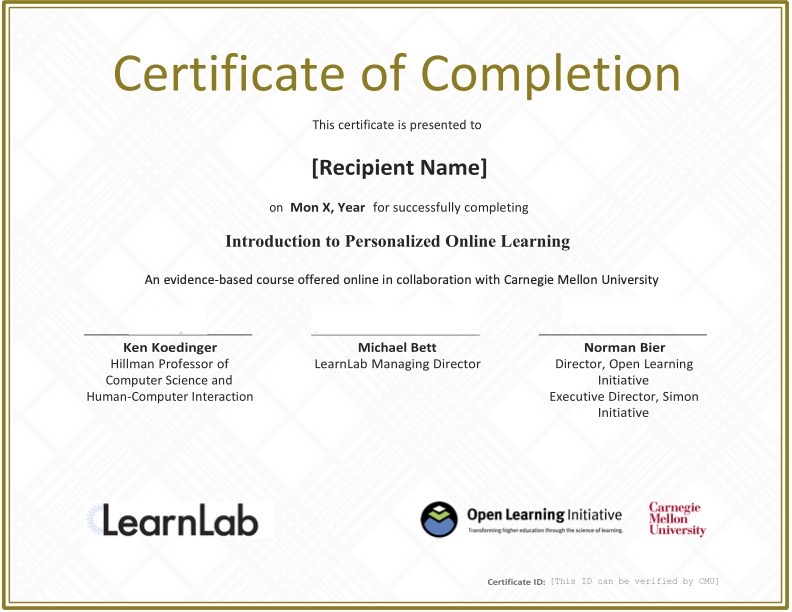Foundations for Online Tool Design


Start Any Time
Work on your pace and you will have instructors available to help you answer any questions.

Duration
Approximately 3 weeks, 6-8 hours/week

Fee
$1500 - Professional Rate
$500 - Full-time Student Rate*
*Proof of full time student enrollment required. Acceptable forms of id include a letter from your university’s registrar office or an unofficial transcript. Email your documents to learnlab-help@lists.andrew.cmu.edu
Certificate Course Description:
Effective educational tools require well-designed interfaces that support actions, interactions, and the presentation of information to support student learning.
In this course we will cover the theoretical constructs that underlie tool design for online learning. The ideas in this course form the foundation for building tools and provide you with a conceptual framework for thinking about tool design. You will learn practical skills for thinking about, building, and studying tools that improve learning on a large scale. These concepts will help you differentiate between tools as well as support your own design decisions when creating your own educational tools.
Our team hosts office hours for all courses over Zoom on the 2nd and 4th Wednesday of each month, 10:00 AM – 11:00 AM EDT/EST (4:00 PM – 5:00 PM CAT). On 2nd Wednesdays, Dr. Ken Koedinger, who is the Director of the Masters of Educational Technology and Applied Learning Sciences (METALS) program, will be available. On 4th Wednesdays, you will have the opportunity to speak with our learning engineers.
Module 1: Theoretical Foundations
- Explain how learning occurs by specifying a model referencing zones of student ability
- Categorize learning tasks into their appropriate zone of ability
- Distinguish between the different mechanisms and processes of scaffolding and fading
Module 2: Properties of Learning Tools
- Describe the ceiling and threshold of a learning tool
- Articulate the effects of thresholds and ceilings in tool design
- Predict the breadth of knowledge types that a tool scaffolds
- Articulate the pros and cons of broader or narrower learning models
Module 3: Interaction Design
- Identify defining properties of direct manipulation and software agent interfaces
- Articulate the effects of scaffolding and fading and when their use is appropriate
- Recognize the pros and cons of direct manipulation and software agent interfaces
- Make reasoned choices between direct manipulation and software agents for interactive designs
Module 4: Course Project
At the end of the course, you’ll have an opportunity to do a project where you will design and create a simple prototype of a learning tool to demonstrate interactions that apply principles you’ve learned in the course. This will provide you with an experience applying the fundamentals you will learn in the modules to a larger, more authentic, context. It will be graded by the instructor and you will receive personalized feedback.
None
The course project allows some opportunity to use technical prototyping skills, but will also allow for less technical prototypes.
Researchers, product/UX designers, instructional designers, or anyone interested in educational technology wanting to learn about, design, and create tools for effective instruction.
What you'll learn
This course will help you:
- Design tools that appropriately assist students given their ability
- Use educational tools to provide assistance and support mastery through scaffolding and fading techniques
- Strive to design tools with low thresholds, high ceilings, and appropriate “trap doors”
- Apply appropriate learning models to your designs
- Make appropriate interface design decisions such as when to use direct manipulation and when to apply software agents
Course Instructors

Dr. Chinmay Kulkarni
Dr. Chinmay Kulkarni is an associate professor of Human-Computer Interaction at Carnegie Mellon University. His research focuses on building technology that uses the networked properties of online communities to improve how people live and learn. His work combines design techniques, AI models, and research on learning to create learning systems that work at scale. This research has already helped 100,000+ students from 130+ countries learn more effectively in MOOCs, and has advanced the science of learning.
Certificate
Upon successful completion of the program, participants will receive a verified digital certificate of completion from Carnegie Mellon University’s Open Learning Initiative.

In addition to the knowledge and immediately applicable frameworks you will gain by attending your selected courses, you will benefit from:
- A digital, verified version of your Executive Certificate (Smart Certificate) you can add to your resume and LinkedIn
- Networking with a global group of your peers and instructors for advancing your career
Register Now
Register and start taking the course in four steps:
1. Enter your email address
2. Watch this short video for instructions on how to register in OLI.
3. For this course, copy the course key: TFOL1-001
4. Click on this link to Carnegie Mellon University’s Open Initiative to register and try out the course for 48 hours before payment is due.
5. (Optional but highly recommended) Set OLI to automatically resume from where you left off in the course.
1) Click on your name in the upper right corner to bring up your OLI profile settings.
2) Change the option on the dropdown to resume automatically.
3) Lastly, select UPDATE.
You are all set!



